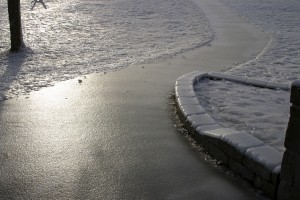 Winter is the worst time of the year for spalling in your patio, walkways, and driveway. Spalling is the process of breaking down ore, rock, stone, concrete, and pavers. The flakes or pebbles broken off in the process are called spall. But, by doing some minor winter maintenance, you can prevent your hardscaping surfaces from spalling and slowly being broken down beneath your feat.
Winter is the worst time of the year for spalling in your patio, walkways, and driveway. Spalling is the process of breaking down ore, rock, stone, concrete, and pavers. The flakes or pebbles broken off in the process are called spall. But, by doing some minor winter maintenance, you can prevent your hardscaping surfaces from spalling and slowly being broken down beneath your feat.
How Winter Increases Spalling
A great deal of the spalling that happens to your hardscaping happens in winter. This is largely due to the cycle of thawing and freezing caused by the erratic temperature variations we experience as part of our temperate climate. Ice or water aren’t problems on their own, the problem is when they switch between states quickly.
The process starts with precipitation. Rain or snow falls and lands on your hardscaping. If it’s in liquid form it penetrates the pores and cracks of your hardscaping. When the temperature drops below the freezing point, 32°F (0°C) , the water freezes and expands. The expansion puts pressure on your concrete, brick, or stone hardscaping and causes it to break. The pore or crack is now larger then it used to be and now when the ice thaws more water can flow into the space. When the temperatures dip below freezing again the expansion of the ice causes even more damage. Fortunately there are things you can do to prevent and mitigate the process.
How Winter Maintenance Can Stop Spalling
By doing simple and regular winter maintenance you can stop, or reduce the damage spalling does to your hardscaping. Making sure your hardscaping is sealed, clearing away snow, and using the right treatments can all help stop spalling in your hardscaping.
Sealing your hardscaping is the first preventative measure you can take to protect your hardscaping. Sealing your hardscaping prevents water from penetrating some of the pores and cracks of your hardscaping. Sealing lasts for approximately three years and should be applied by a professional. However, on its own sealing isn’t always enough to protect your hardscaping.
Clearing your hardscaping of snow and ice is important for preventing spalling. By clearing your hardscaping you prevent the cycle from starting in the first place. When you’re clearing your hardscaping you should use a plastic shovel or a metal shovel with a rubber covering the blades edge. A regular metal shovel blade can scratch or otherwise damage your hardscaping. It’s best to clear right after a snow, or intermittently during the snow if it’s a heavy snow.
Finally, treating ice and snow with chemicals can be done to prevent the cycle of freezing and thawing, however it must be done with caution. Certain chemicals, even just plain salt, can cause damage to your hardscaping. Make sure you consult with your hardscaping provider or installer to find out what chemicals are safe to use on your hardscaping.
Need Help or Have Questions?
Call Tristate Paving. We’re a seasoned hardscaping company based in Maryland and have the experience and knowledge to help you care for and maintain your hardscaping.
Our area numbers are:
West Chester: 610.563.9456
Oxford: 610.932.3566
Delaware: 302.757.4100
Check back here for weekly updates on current projects, important paving facts and info, and smart ideas for homeowners interested in concrete, asphalt or hardscaping work.
Follow us on Facebook, Twitter, Pinterest, and Google+
Tags: hardscaping, winter hardscaping maintenance, winter maintenance
 ASPHALT
ASPHALT
 Commercial
Commercial
 Residential
Residential
 DOT
DOT
 Decorative
Decorative
 Sealcoating
Sealcoating
 Infrared Repairs
Infrared Repairs
 CONCRETE
CONCRETE
 Flat Work
Flat Work
 Decorative
Decorative
 Curbs/Gutters
Curbs/Gutters
 Steps
Steps
 Slab Jacking
Slab Jacking
 Pump Trucks / Pump Trailers
Pump Trucks / Pump Trailers
 HARDSCAPES
HARDSCAPES
 Walls / Borders / Curbs
Walls / Borders / Curbs
 Walks / Patios
Walks / Patios
 Aprons
Aprons
 Steps
Steps
 Columns / Fire Pits
Columns / Fire Pits
 Outdoor Kitchens
Outdoor Kitchens